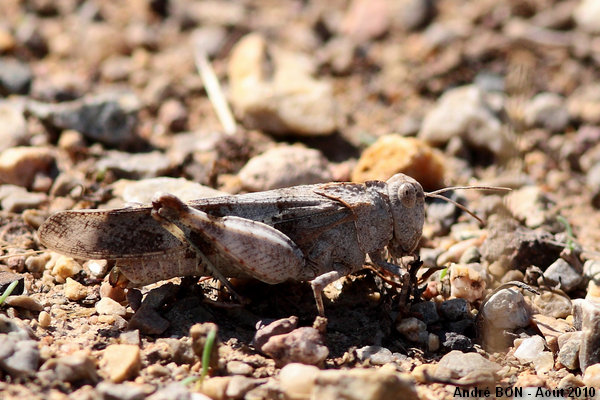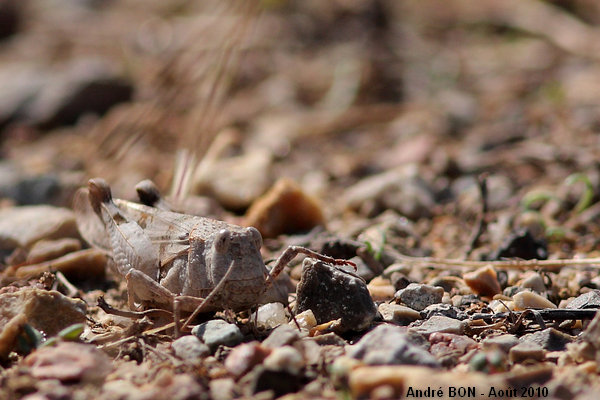

| Blue-winged Grasshopper (Oedipoda caerulescens (Linnaeus, 1758)) |


|
|
Scientific name: Oedipoda caerulescens (Linnaeus, 1758) Common name: Blue-winged Grasshopper French name: Oedipode turquoise, Oedipode bleue, Oedipode bleuâtre, Criquet bleu, Criquet aux ailes bleues. Order: Orthoptera Family: Acrididae Wingspan : Males: 15 to 21 mm; Females: 22 to 28 mm. Biotope: On the ground, in dry places with bare ground or sparse and low vegetation (dunes, heathlands, quarries, etc.) Geographic area: Europe, North Africa, Asia. Observation period : July to early November. |
The colour of the Blue-winged Grasshopper's body is similar to the colour of the ground in its habitat (grey, yellowish or reddish brown). This provides a good camouflage in the environment. The fore wings are crossed by two or three pale stripes. The upper side of the pronotum shows a very small notch. The carina on the upper side of the femora has also a well marked notch. The most typical characteristic is the blue turquoise colour of the hind wings which is only visible in flight. The hind wings also show a large black marginal stripe. The Blue-winged Grasshopper feeds on grasses. It almost does not emit any sound. Females lay the eggs in the soil. The Oedipale Occidentale (Oedipoda charpentieri), which has also blue, but paler, hind wings, can be recognized by the strong notch located on the upper side of the pronotum. The carina of the first part is prominent. The pronotum also looks more rugous. The black stripe bordering the hind wings extends on the costal edge by more than the half of the length. This extension is much shorter on the Blue-winged Grasshopper. You can tell the Red-winged Grasshopper (Oedipoda germanica) apart, as mentioned by its common name, with its red hind wings. It is very difficult to tell it apart from Oedipoda caerulescens when you haven't seen the colour of the hind wings. The Slender Blue-winged Grasshopper (Sphingonotus caerulans) also shows blue hind wings. There is no black marginal band. The femora does not show any notch and the pronotum is anteriorly constricted. |
| [To know more about the Blue-winged Grasshopper] [Next picture] [Top] |

|
Blue-winged Grasshopper (Oedipoda caerulescens) or Red-winged Grasshopper (Oedipoda germanica)? The notch on the upper side of the pronotum is small. You can see that there is also a notch on the upper side of the hind femora. So the species is one of the two listed above. I wasn't aware that this was a coloured grasshopper species when I have done this observation. So, taking care not to disturb, I haven't pushed it so that it flies away. If I go back there one day, I will make it fly to try to shoot a more coloured picture. In the meantime there is still a doubt about the species identification. |
| [To know more about the Blue-winged Grasshopper] [Previous picture] [Top] |

|
The Blue-winged Grasshoppers adapt to the colour of their habitat since the beginning of their growth. This one is a good example. |